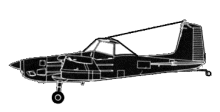
ASN Wikibase Occurrence # 291270
This information is added by users of ASN. Neither ASN nor the Flight Safety Foundation are responsible for the completeness or correctness of this information.
If you feel this information is incomplete or incorrect, you can submit corrected information.
| Date: | Monday 25 July 2016 |
| Time: | 18:00 LT |
| Type: |  Cessna 188 |
| Owner/operator: | |
| Registration: | N9979G |
| MSN: | 18800779 |
| Year of manufacture: | 1971 |
| Total airframe hrs: | 5344 hours |
| Engine model: | Continental O-470-U |
| Fatalities: | Fatalities: 0 / Occupants: 1 |
| Aircraft damage: | Substantial |
| Category: | Accident |
| Location: | What Cheer, Iowa -
 United States of America United States of America
|
| Phase: | Manoeuvring (airshow, firefighting, ag.ops.) |
| Nature: | Private |
| Departure airport: | Gibson, IA |
| Gibson, IA | |
| Investigating agency: | NTSB |
| Confidence Rating: |
The pilot reported that he was performing "practice" aerial application operations at 30 feet above the ground and the engine slowly lost power. He further reported that he made a left turn and landed in a bean field, which resulted in substantial damage to the right wing and left elevator.
During postaccident interviews with the pilot, he reported that immediately before the loss of engine power he was flying wings level, the mixture was forward (full rich), and the power was set to a cruise setting. He further reported that the carburetor heat was off for the entirety of the flight. The pilot reported that the loss of engine power was gradual and there was no visible oil spray over the windscreen. He reported that immediately after the accident he checked the oil level and found no anomalies.
During a postaccident examination, an airframe and powerplant mechanic reported that he drained 13 gallons of fuel from the single fuel tank. He further reported that he observed the float carburetor and gascolater, both were unremarkable. He also reported that the propeller could be rotated in a normal manner.
The Federal Aviation Administration Pilot's Handbook of Aeronautical Knowledge (PHAK) states in part: "Carburetor ice occurs due to the effect of fuel vaporization and the decrease in air pressure in the venturi, which causes a sharp temperature drop in the carburetor. If water vapor in the air condenses when the carburetor temperature is at or below freezing, ice may form on internal surfaces of the carburetor, including the throttle valve."
The PHAK further states: "If enough ice builds up, the engine may cease to operate. Carburetor ice is most likely to occur when temperatures are below 70 degrees Fahrenheit (°F) or 21 degrees Celsius (°C) and the relative humidity is above 80 percent. Due to the sudden cooling that takes place in the carburetor, icing can occur even in outside air temperatures as high as 100 °F (38 °C) and humidity as low as 50 percent. This temperature drop can be as much as 60 to 70 absolute (versus relative) Fahrenheit degrees (70 x 100/180 = 38.89 Celsius degrees)."
An automated weather observing system about the time of the accident 13 nautical miles northeast of the accident site reported a temperature of 81 degrees Fahrenheit (27 Celsius) and a dew point 66 degrees Fahrenheit (19 Celsius). According to a carburetor-icing-probability chart, the engine was at risk of "moderate icing" at cruise power.
The airplane manufacturer owner's manual in part states: "In atmospheric conditions that are conducive to carburetor icing, select the minimum amount of carburetor heat for normal operation that will keep ice cleared from the carburetor."
It is likely that the loss of engine power was due to carburetor ice, however, the pilot, who was also the airplane owner, did not make the airframe or engine available for examination by the National Transportation Safety Board.
Probable Cause: The loss of engine power for undetermined reasons due to the pilot not making the airplane or engine available for examination, which resulted in a forced landing and an impact with terrain.
Accident investigation:
 |
|
Sources:
NTSB GAA16CA393
Location
Revision history:
| Date/time | Contributor | Updates |
|---|---|---|
| 07-Oct-2022 11:49 | ASN Update Bot | Added |
Corrections or additions? ... Edit this accident description
The Aviation Safety Network is an exclusive service provided by:


 ©2024 Flight Safety Foundation
©2024 Flight Safety Foundation